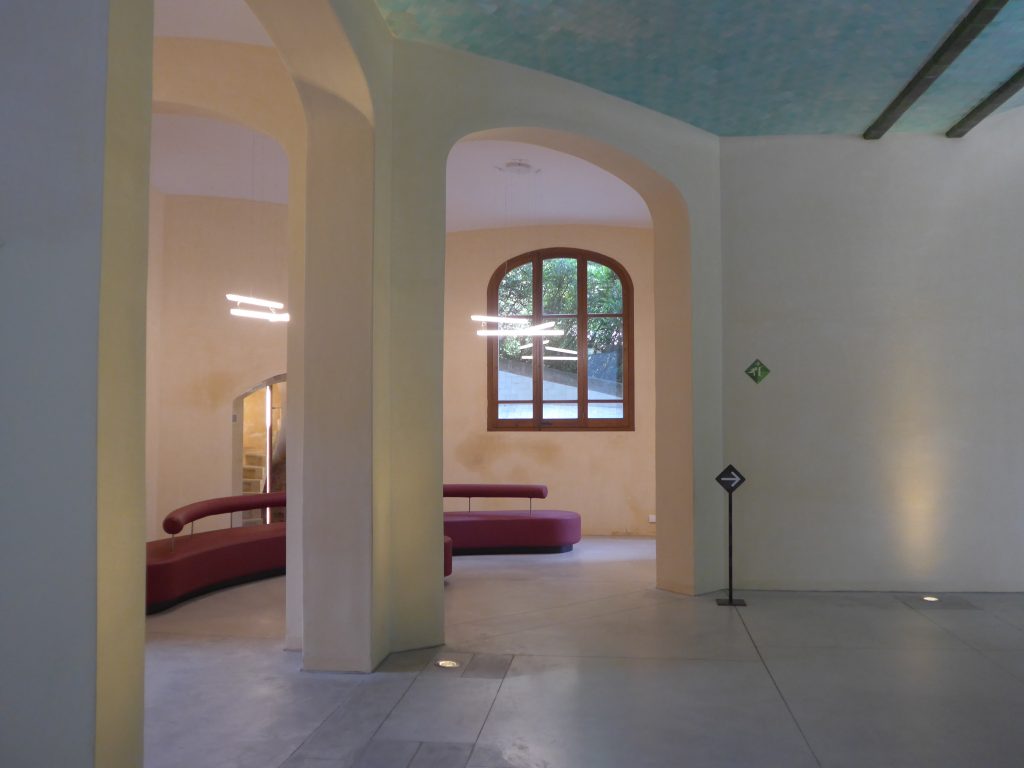Word of Mouth: Barcelona
Several stunning spots to visit in one of our favorite cities

From the tight medieval alleys of Barcelona’s Gothic Quarter to Eixample’s carefully planned, uniquely shaped octangular blocks (the cut-off corners transform every intersection into more open plazas), Barcelona bursts with history, spirit, and inspiration—it’s a city that renders even the most fervent minimalist design lovers speechless and transforms them into romantics, with a little help from Gaudí and friends. In between the voluptuous, biomorphic, elaborate, and ornate Catalan takes on Art Nouveau (aka Modernisme), below are recommendations for where to stop and take a breath. For additional Barcelona take a look at our Word of Mouth: Barcelona guide from earlier this year and our personal notes on visiting the city.

La Dama
On Avinguda Diagonal lies a Modernisme mansion—Casa Sayrach, built around 1917. Walk through the jawdropping ground floor lobby, past an elevator with twinkly mosaic embellishment, up a half flight of stairs, and knock on a heavy door of what seems to be an apartment—and inside is a restaurant. A snow-globe of intimacy, La Dama serves European classics but many guests are really there for the Art Deco interior and 1920s speakeasy atmosphere. With no direct exit to the sidewalk, the thoughtfully decorated restaurant beckons visitors to stay for hours—like a perfect dinner party at someone’s house.

Sir Victor
Named for Víctor Català—the pseudonym of Catalan writer Caterina Albert i Paradís, an “unconscious feminist” ahead of her time—Sir Victor is a 91-room hotel in L’Eixample. With gloriously design public spaces by Baranowitz + Kronenberg, the vibe is decidedly sophisticated and elegant, but still laidback. And even with its rooftop bar and pool, luxurious spa and more, it’s the hotel’s location (just steps from Gaudí’s Casa Milà, and countless other Modernisme structures) that really makes it the ideal place to stay when visiting the stunning city.

Side Gallery
Founded in 2015 by two architects, Side Gallery is based in Barcelona but specializes in 20th-century designs from across the Latin America diaspora, like Luis Barragán, Oscar Niemeyer, Lina Bo Bardi, and Joaquim Tenreiro—the latter two who chose Brazil as their permanent home. The gallery also hosts international contemporary designers; their recent exhibition TURN ME ON…NOW! (pictured above) showcased 15 different experimental “lightings” made just for the show. Highlights include James Shaw’s twisty, theremin-esque “Woodmetalplastic,” Brian Thoreen’s wall-mounted ribbons (which echo an unrolled paper towel), and Marcin Rusak’s silver heart-shaped sconces. Rusak, a Polish artist inspired by nature and waste, made these lights from found metal and real leaves metalized with zinc. Scroll through Side Gallery’s entire lighting section online for even more lamps reckoning with their identity.

Morro Fi
In Barcelona, vermouth (or vermut) is not a mere cocktail ingredient or drink; it’s a state of mind. The easy-sipper usually makes an appearance before lunchtime, on the rocks accompanied by an orange slice, and bows out before the sun sets, as a prelude to a bigger meal. A wonderful place for homemade, herbaceous vermouth and salty bites is Morro Fi (which loosely translates to “a refined snout,” or someone with good taste) at any of their few tiny locations scattered throughout the city. If you’re checking in a suitcase on the flight back, be sure to add a few Morro Fi bottles—very affordable—to the total tab.

Hospital de la Santa Creu i Sant Pau
An off-the-beaten-path recommendation for those who’ve already seen the major destinations like Park Güell and La Sagrada Familia is Hospital de la Santa Creu i Sant Pau. A public hospital ahead of its time, it was set up in the early 1900s like a university campus, with walkable gardens for patients and even underground tunnels connecting the various Art Nouveau pavilions designed by Lluís Domènech i Montaner, an architect who loved mosaic. Rich with the modern history of healthcare, and much more interactive than browsing paintings at a museum, visits are tranquil and therapeutic. Makes you wonder if hospitals (and even buildings in general) aimed to be more beautiful, what wonders it could do for our health.

CLAY
On our walk through the El Born neighborhood, we stumble into CLAY—a self-described Mediterranean lifestyle store—and walk out with reasonably priced, carefully packaged, handblown amber glassware from Syria. It takes much willpower not to leave with far more; the homewares in this boutique are worth reserving an extra check-in bag for. Founded by interior designer friends who travel around the world to come face to face with artisans and their craftmanship, CLAY exudes a sincerity and unique soulfulness that newer shops can sometimes lack (perhaps because it feels like, these days, every boutique is stocking the same jute rugs and baskets). Hand-painted plates, Anatolian linen tablecloths, teak furniture from Indonesia, and more await—plus a particularly strong speciality in one-of-a-kind rings and other jewelry.












